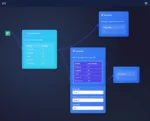
by tyler garrett | Jun 27, 2025 | Data Visual
In the high-stakes realm of climate change, the ability to translate vast pools of environmental data into actionable intelligence is not merely valuable—it’s transformative. Imagine if, instead of looking at dense rows of temperature figures, carbon emissions, or oceanic acidity levels, decision makers could intuitively see the future unfolding before their eyes. Climate data visualization is the bridge between raw environmental statistics and informed strategic action; it empowers leaders and policymakers to intuitively grasp complex data narratives, predict trends proactively, and adapt to ecological shifts with precision. At our consultancy, we specialize in advanced Tableau consulting services, equipping decision makers with stunning, informative dashboards and analytics capabilities. As the global consequences of ecological disturbances accelerate, data visualization stands alongside analytics and innovation as an indispensable tool—not merely informing but guiding powerful, meaningful decisions toward environmental resilience. Let’s unpack the extraordinary potential that data-driven visualization unlocks for those steering organizations through the complexities of climate decision-making.
The Cornerstone of Sustainability: Understanding Data Visualization
Why Data Visualization is Powerful for Environmental Decision Makers
Climate-related decision making involves interpreting massive volumes of data from diverse sources—including atmospheric sensors, satellite data, emissions reports, and research studies. Raw data can be challenging to interpret and nearly impossible to act upon without the proper tools. This is where effective data visualization comes into play, transforming overwhelming datasets into intuitive graphics, charts, and interactive dashboards. Visualization simplifies complexity, exposing patterns and insights that would otherwise remain hidden or difficult to decipher. With powerful analytics frameworks and interactive tools like Tableau, data analytics specialists guide stakeholders beyond mere numbers towards impactful environmental policy and timely strategic adjustments.
Decision makers benefit significantly from visualization capabilities that display real-time analytics. We’ve observed outstanding successes when leveraging interactive dashboards linked directly to continuously updated climate metrics. For example, our team has created dynamic real-time monitoring dashboards, in projects similar to our guide on Building a Real-Time Dashboard with Streamlit and Kafka, empowering stakeholders to detect concerning environmental anomalies precisely when intervention can yield significant benefits.
Visual analytics provide a strategic advantage by highlighting trends, risks, and opportunities instantaneously. Decision makers equipped with these capabilities are proactively positioned, ready to pivot swiftly in response to fluctuating climate realities, ensuring optimal resource allocation and driving sustainable positive outcomes.
Transforming Environmental Data into Strategic Insights
ETL and Analytics: Turning Raw Climate Data into Decision-Grade Intelligence
The backbone of any robust data visualization pipeline lies in the critical step of data transformation—Extract, Transform, Load (ETL). Reliable climate data visualization depends significantly on meticulous data analytics processes, much like we’ve discussed in ETL in Data Analytics is to Transform the Data into a Usable Format. This ETL process ingests messy, varied, and incomplete environmental datasets and refines them into clean, standardized formats optimal for insightful visualization.
In practice, extracting actionable insights from climate data often involves integrating vast statistical sets, real-time sensor outputs, and diverse historical environmental records. Simplifying and transforming these complex and enormous datasets into streamlined analytical structures requires expertise in advanced analytics platforms and strategies. For instance, we often engineer tailored data engineering pipelines compatible with platforms such as Tableau, which enables rapid visualization of massive datasets, translating raw content into richly interactive visual narratives ready for policy evaluation and action.
Data transformation also ensures quality and trustworthiness—paramount characteristics in climate decision-making—which highlights the inherent necessity for implementing Data Trust Implementation for Protected Information Sharing. By emphasizing transparency and reliability of analytics at every stage, decision makers can confidently depend on the accuracy and integrity of the insights they visualize, fostering lasting sustainability solutions.
Leveraging Predictive Climate Analytics for Proactive Adaptations
Forecasting Future Climate Trends with Data Modeling and Prediction
Visualization becomes even more powerful when decision makers deploy predictive modeling tools on top of environmental data. Through predictive analytics integrating machine learning frameworks and open-source platforms, similar to what we discuss in our blog on Predicting Client Churn with Open-Source Tools, organizations can foresee potential impacts, anticipate climate risks, and rapidly adapt strategic direction.
Predictive models may forecast coastal flooding events, temperature shifts, extreme weather patterns, or species migration—all of which represent pivotal aspects of adapting to climate change. Such insights significantly elevate effectiveness in both short-term policy tweaks and longer-term strategic initiatives. Similar to our recent implementation in the business domain described in Enhancing Customer Experience: 5 Ways Analytics and Data Engineering Drive Improvement, predictive analytics can enhance environmental initiatives by providing clear foresight about critical climate shifts and ecosystem changes.
By combining insightful analytics with interactive visual modeling dashboards, organizations can experiment with scenarios, stress-test climate responses, and assess risks proactively, supporting informed environmental management actions. Decision makers become instantly more effective, responding to climate changes confidently amidst complexity in an actionable, evidence-based fashion.
Addressing Data Integrity and Security in Climate Visualizations
Assuring Data Quality, Security, and Analytical Robustness in Climate Analytics
Climate data visualization platforms must handle immense and multifaceted datasets—raising inevitable questions of data accuracy, integrity, and security. Ensuring data protection and secure sharing of sensitive analytical models is critical within environmental and governmental organizations, confirming the strategic value of climate analytics remains uncompromised.
At our consultancy, we emphasize safeguarding analytical processes through techniques like Adversarial Robustness in Automated Data Analysis. Building robust analytical tools that maintain accuracy under varying pressures or vulnerabilities is critical for trustworthy climate mitigation strategies. Furthermore, methodologies outlined in our exploration of The Art of Data Fingerprinting: Detecting Duplicate Records at Scale allow us to ensure continuous data quality and detect inaccuracies quickly, thereby creating a reliable foundation for accurate climate insights.
By proactively employing strategies that secure data, mitigate vulnerabilities, identify irregularities, remove duplicates, and confirm credible data flows, decision makers can trustfully proceed with informed climate policy choices, confident their strategic decisions rest upon fully reliable analytical foundations.
How Innovation and AI Are Advancing Climate Analytics
Smart Analytics: AI-Driven Data Visualizations and Decision Support Systems
Cutting-edge innovations and artificial intelligence (AI) solutions greatly enhance climate data visualization and analytics. AI-driven analytics systems, such as the one described in our related study What We Learned Building an AI Assistant for Client Intake, combine massive environmental data streams, predictive modeling, and real-time analysis in powerful, automated decision support systems.
These next-generation climate analytics platforms deliver a uniquely comprehensive ability to visualize, simulate, and adequately prepare for fundamental ecological evolutions. AI-enhanced analytic visualizations effortlessly sift through voluminous climate data, continually updating visual-impact scenarios accessible to decision makers at unprecedented speeds and with unparalleled precision.
Innovation empowers stakeholders confronting climate challenges to grasp strategic opportunities proactively, optimize resource allocation, and develop solutions swiftly ahead of emerging ecological disruptions. As AI and advanced analytics tools become increasingly sophisticated, proactive environmental strategy backed by intelligent visual insights emerges not only possible but strategically advantageous.
Conclusion: The Future Landscape of Climate Decision Making
As our planet faces escalating climate threats, precision-informed environmental decisions matter immensely to sustainable futures. Data visualization, analytics, and AI stand at the forefront, combining analytical expertise and accessible insights essential for ecological resilience. Decision makers utilizing sophisticated visualization tools and strategies effectively equip organizations to respond with agility, foresight, and confidence in navigating complex climate-decision landscapes, leveraging innovation to build a secure environmental foundation for future generations.
Thank you for your support, follow DEV3LOPCOM, LLC on LinkedIn and YouTube.

by tyler garrett | Jun 25, 2025 | Data Visual
In today’s dynamic digital landscape, businesses depend heavily on microservices to achieve scalability, agility, and rapid innovation. As organizations scale their applications, Application Programming Interfaces (APIs) emerge as essential connectors enabling seamless communication across different microservice components. However, a robust strategy for API performance monitoring and visualization isn’t just beneficial—it’s indispensable. Without meaningful visualization and monitoring tools in place, technical leaders and decision-makers risk flying blind into operational turbulence. At Dev3lop, we guide our clients through the maze, harnessing advanced data analytics, thoughtful innovation, and strategic consulting to translate raw API performance data into clear, actionable visual insights. Let’s explore powerful strategies to effectively monitor microservices APIs and harness the full potential of visualization tools in optimizing your organization’s software infrastructure.
Understanding the Importance of API Performance Monitoring in Microservices
Microservices architecture allows businesses flexibility, agility, and faster deployment cycles by breaking down complex applications into smaller, independent services. However, these benefits come at a cost—complexity in monitoring interactions among multiple APIs. APIs drive critical interactions between individual microservices—ensuring these components communicate efficiently—and therefore API performance directly affects overall system health and user experience. A single failing or suboptimal API can quickly propagate problems throughout your distributed environment.
Proactively monitoring API performance metrics—such as response time, error rates, throughput, and availability—is essential to detect and resolve bottlenecks early. Robust monitoring informs decisions on scaling, load balancing, and optimizing resources. For decision-makers responsible for aligning technical strategies within evolving infrastructures, transparent and efficient API performance monitoring helps mitigate risks and enhances trust across software development and operations teams.
Leveraging performance visualization combined with expert Azure consulting services significantly boosts understanding and management of these complex microservices ecosystems. Visual dashboards translate data into valuable insights, empowering engineers and executives alike to quickly diagnose issues and make data-driven improvements promptly and confidently.
Critical Metrics for Effective API Monitoring
To measure API efficacy, it’s crucial to identify and track meaningful metrics specific to your organization’s microservices environment. Focusing solely on response time doesn’t fully capture API health—leaders should instead adopt a composite suite of metrics for balanced insight:
Latency and Response Times
API latency—the time it takes for an API call to respond—is a fundamental indicator of user experience. High latency decreases customer satisfaction and signals potential performance bottlenecks. Key metrics include average response times, percentiles, and maximum latency spikes.
Error Rates and Failures
Tracking error rates—including HTTP response codes (such as 4xx and 5xx)—secures early detection of issues. High-level visualization dashboards highlighting error codes help teams rapidly locate problems and apply targeted solutions. Proactive analysis of error patterns also feeds directly into continuous improvement strategies.
Throughput and Request Volumes
Throughput—requests processed per second by your APIs—illustrates system capacity. Tracking throughput helps teams gauge the system’s baseline behavior and plan for scaling infrastructure during peak usage. Understanding regular traffic patterns assists with accurately forecasting future resource allocation needs.
By clearly measuring these critical dimensions, teams gain the comprehensive view required for reliable decision-making. Accurate metrics combined with advanced visualization allow technical leadership to quickly pinpoint anomalies and contextually interpret performance issues, enabling proactive optimization.
Advanced Data Visualization Techniques for Root Cause Analysis
API performance data is powerful only when communicated effectively. Raw data tables and numbers alone cannot reliably surface meaningful patterns, trends, or anomalies. Technical leaders require intuitive visual dashboards to quickly interpret real-time API health. This is where advanced data visualization techniques become indispensable.
Time-series visualizations offer visibility into performance patterns, helping teams discover trends, seasonality, and operational anomalies. Utilizing effective strategies such as Entropy-based Anomaly Detection provides innovative ways to proactively detect subtle patterns signaling potential disruptions.
Interactive visualizations allow quick drill-down analyses, enabling specialists to uncover deeper root causes efficiently. Furthermore, tree maps, heatmaps, and geo-distributed visualizations enable rapid understanding of complex problems linked to geography, microservice interactions, or resource bottlenecks. These visual tools complement exploratory techniques such as recursive viewing patterns explored in our past article: Recursive Materialized Views for Hierarchical Analytics.
Harnessing sophisticated visualization platforms—such as custom-built dashboards or analytics solutions integrated into cloud platforms—can significantly reduce the time to meaningful insights and accelerate issue resolution. Investing in these advanced visualization strategies transforms raw API performance data into actionable intelligence for broader strategic decision-making.
Implementing Continuous Improvement and Real-time Alerting Systems
Visibility without action is insufficient. Establishing a proactive monitoring strategy involves a continuous improvement mindset combined with real-time performance alerts triggered by key threshold breaches. By configuring automated monitoring and alerting, development and operations teams promptly receive actionable notifications regarding performance deviations—enabling faster recovery and downtime reduction.
Incorporating real-time monitoring alerts into your CI/CD Pipeline delivers critical operational benefits seamlessly, ensuring faster delivery cycles without compromising performance quality. Leveraging automated alert tools integrated directly into existing operational workflows ensures adherence to pre-defined service-level agreements (SLAs) and reduces manual intervention.
Strategic API performance visualization coupled with alerting capabilities provides comprehensive benefits, significantly impacting overall operational excellence. Continuous monitoring helps teams stay ahead of emerging issues and fosters proactive operational behaviors, solidifying a culture of continuous learning and agile improvement within organizations—as discussed in our careful approach to continuous improvement in predictive analytics: Continuous Learning for Demand Forecasting.
API Governance, Data Quality, and Deprecation Management
Effective monitoring strategies encompass more than merely tracking real-time API performance metrics. Forward-thinking leaders understand the critical importance of API governance—a robust framework that establishes clear data quality standards, lifecycle management, and communication of API health across the organization.
API endpoints inevitably evolve, requiring thoughtful management and proactive deprecation plans. Organizations must implement structured processes ensuring API deprecation minimizes disruption to developers and end-users. Detailed insights into API consumption patterns assist organizations in making informed decisions around when and how APIs are deprecated, as discussed in our detailed breakdown: Implementing Data Asset Deprecation Workflows.
Additionally, establishing strong data quality standards within your APIs proactively ensures trustworthiness and reliability—crucial factors forming the foundation of data-informed decision-making. Data quality monitoring allows companies to assess API health beyond basic uptime measures by applying clearly defined thresholds identifying potential data degradation or anomalies.
Together, API governance, data quality management, and sophisticated performance monitoring visualization frameworks empower organizations to evolve microservice APIs without risk or ambiguity continuously. They form essential building blocks for maintaining resilient API-driven ecosystems—supports innovation, accelerates software velocity, and enables robust digital transformation journeys.
Building Expertise: Enhancing Your Microservice Infrastructure
Successfully managing APIs within complex microservices environments necessitates ongoing technical refinement and talent development. Many organizations find substantial value partnering with experienced technical strategists to enhance their data environments—clarifying complexities and navigating future challenges expertly.
Understanding what it’s like hiring engineers specialized in data environments ultimately simplifies the journey toward adopting increasingly agile API performance monitoring and visualization frameworks. Such specialized expertise is essential for identifying constraints, designing powerful visualizations, and integrating scalable monitoring frameworks into your technology stack.
Organizations choosing thoughtful strategic investment in specialized consulting services gain practical clarity around API performance metrics, optimize visualization features, and effectively implement governance structures. Ultimately, expert knowledge combined with data-driven strategies generates significant business value, reduces associated technology risk, and accelerates long-term capability development.
Our team at Dev3lop specializes in supporting organizations through every step of data maturity, from initial monitoring strategies to refined performance visualizations, crafting powerful analytical experiences that drive innovation, scalability, and excellence in digital capabilities.
Thank you for your support, follow DEV3LOPCOM, LLC on LinkedIn and YouTube.

by tyler garrett | Jun 25, 2025 | Data Visual
The future of human resource management lies firmly in harnessing the strategic advantage of workforce analytics dashboards. Imagine being equipped with powerful insights that not only accurately reflect current workforce dynamics but also empower proactive decision-making that drives productivity, enhances talent management, and accelerates your business growth. With today’s rapid advancements in data analytics technology and sophisticated visualization techniques, HR leaders now hold unprecedented power to transition from reactive administrative support to proactive strategic partnership. Let’s explore how workforce analytics dashboards are revolutionizing HR, enabling leaders to turn complex datasets into crystal-clear opportunities, pinpoint inefficiencies, and thoroughly understand workforce dynamics. It’s time to turn your HR department into a crucial strategic asset and start championing innovation and growth through effective workforce analytics.
The Strategic Role of Dashboards in HR Analytics
Human Resources has evolved from merely administrative to being an indispensable strategic pillar within a successful business. Central to this evolution is the adoption of analytics dashboards, a powerful tool providing immediate insights and facilitating informed decision-making. HR analytics dashboards collect, visualize, and provide actionable insights in real-time, enabling HR executives to identify trends and deploy solutions rapidly. A strategically designed dashboard can improve recruitment processes, identify skill gaps promptly, enhance employee engagement, and forecast attrition effectively. Adopting workforce analytics leverages sophisticated tools like Microsoft Azure for enterprise-level data analytics; consider consulting with specialized experts like our team at Dev3lop for comprehensive Azure Consulting Services.
A well-crafted analytics dashboard functions as a Single Source of Truth, unifying disparate HR data sources into coherent, impactful visuals. Leadership and HR teams can quickly make comparisons, measure actual performance versus goals, diagnose why attrition rates might be rising, and deploy timely interventions to reduce employee turnover. By embedding analytics dashboards within HR processes, organizations become more agile, data-driven, and strategically insightful in their workforce management decisions.
How Real-Time Workforce Analytics Drives Immediate Impact
Real-time human resource analytics dashboards are redefining the pace at which HR professionals can make crucial workforce decisions. Unlike traditional methods that depended largely upon historical data, real-time analytics offer immediate insight the moment changes occur—effectively empowering HR management to act promptly. Real-time data integration and processing techniques, such as the ones explored in our article on real-time data processing best practices, can be particularly valuable for HR dashboards. These tools ensure data accuracy, consistency, and timeliness, key elements for informed strategic decisions in HR.
When presented through intuitive visual methods—such as Violin or Box plot visualizations, covered in our guide on when to use Violin Plots vs Box Plots—real-time dashboards can identify outliers, variations, and internal anomalies. These visualizations support HR professionals in promptly interpreting the meaning behind complex statistical nuances, from performance variation across teams, to unexpected increases in absenteeism. Real-time analytics dashboards equip HR departments to identify challenges swiftly, devise impactful solutions immediately, and transform from reactive decision-makers into strategic workforce planners.
Enhancing Talent Management and Employee Engagement
One of the most impactful applications of workforce analytics dashboards lies in enhancing talent management and significantly heightening employee engagement. Dashboards can incorporate predictive analytics models, similar to the strategies discussed in our guide on enhancing demand forecasting with predictive analytics. Predictive analytics allows HR teams to proactively identify and support at-risk employees, spot top performers early on, and dynamically align workforce talent with immediate business objectives.
Dashboards enable HR departments to track performance metrics, learning and development outcomes, and engagement survey results continuously. This hawkish-eye tracking helps in crafting tailored talent development programs and targeted retention strategies. Well-designed dashboards contribute tremendously toward fostering a data-driven HR culture focused on understanding and nurturing workforce strengths, positioning your organization as an attractive, growth-minded employer that retains and motivates top-tier talent.
Minimizing Workforce Downtime with Predictive Analytics
Analytics dashboards also excel in addressing one of the most significant challenges confronting businesses today—unexpected downtime. This isn’t just about equipment; it’s about the human capital aspect too. Predictive analytics approaches described in our insightful article, Predicting the Future of Maintenance and Minimizing Downtime, translate efficiently within workforce analytics as well. By applying predictive modeling into workforce analytics dashboards, HR departments can foresee potential downtime due to absences, attrition risks, talent gaps, or skills mismatches.
Advanced analytics coupled with dashboard offerings allow organizations to develop proactive staffing strategies to minimize productivity losses before they occur. HR data becomes forward-looking rather than merely diagnostic, prompting strategic allocation of resources and shifting HR department functionality from primarily reactive firefighting to proactive workforce optimization. Prediction enables improved readiness, ensures business continuity, and enhances overall operational productivity—all achievable with a workforce analytics dashboard solution.
Best Practices for Deploying Workforce Analytics Dashboards
Effectively deploying workforce analytics dashboards hinges upon adhering to industry-proven best practices. One vital approach includes scalability considerations. Similar to insights discussed in our data engineering study on scaling for high volumes of events, workforce dashboards must be designed from the start to seamlessly scale with growing datasets. HR departments accumulating vast amounts of personnel data from multiple applications need dashboards engineered for efficiency, speed, and reliability.
Additionally, optimizing your dashboard workflows bears resemblance to enhancing analytics workloads with Spark performance improvements, due to the similarities in large data processing—something explained further in our article on 10 best practices for optimizing Spark Jobs. Follow a set process—starting with defining clear KPIs and establishing continuous feedback loops—to ensure dashboards remain timely and actionable. Don’t overlook critical elements such as data deletion verification and certification processes; ensuring compliance and accuracy is foundational to insightful HR analytics.
Managing Global, Multilingual Workforce Data
In an increasingly globalized business landscape, organizations often manage multilingual talent pools. Your HR analytics dashboard should seamlessly support multinational interfaces and multilingual datasets. Our recent industry guide on multi-language support in data definition repositories highlights the importance of inclusive data systems.
A well-executed multilingual workforce analytics dashboard ensures inclusivity, accuracy, and significantly improved user adoption. Ultimately, user experience matters greatly. User-friendly multilingual dashboards invite global teams to engage more profoundly with HR analytics, generating deeper insights and data-driven decisions. Consequently, HR operates more cohesively worldwide, translating into increased productivity, improved global talent management, and efficient, unified insights that drive worldwide business success.
Turning Your HR Analytics Dashboard into Executive Storytelling
The pinnacle achievement of successful workforce analytics dashboards is translating complex data into business narratives compelling to executives. Effective dashboards refreshingly combine visualization with storytelling—a powerful strategy we explore critically in our article focused on Executive Data Storytelling. HR leaders can use dashboard narratives to distill analytics into clear human resource strategies that executives appreciate, understand, and can act upon swiftly.
Successful data storytelling amplifies HR analytics impacts, creating engaging strategic conversations among executive leadership teams and HR specialists. When dashboards speak in terms executives can resonate with, HR becomes an influential strategic partner rather than mere support function, vividly demonstrating the ROI of robust HR analytics investments throughout the entire enterprise.
Conclusion: Embracing the Evolution of Workforce Analytics Dashboards
Workforce analytics dashboards aren’t futuristic—they’re an HR reality that visionary businesses must adopt. These analytically rich dashboards empower decision-makers, drive strategic workforce initiatives, and stimulate profound HR impact across enterprises. Take the lead in propelling your organization into a future powered by innovation, data utilization, and clear unmatched workforce excellence.
Tags: Workforce Analytics, HR Dashboards, Predictive Analytics, Real-time Analytics, Talent Management, Data-Driven HR
Thank you for your support, follow DEV3LOPCOM, LLC on LinkedIn and YouTube.

by tyler garrett | Jun 25, 2025 | Data Visual
In the rapidly evolving world of innovation, patents represent a strategic leverage point that can make or break an organization’s competitive advantage. Patents hold immense value, but they can also be overwhelming to analyze. How do technology leaders efficiently navigate through thousands of dense patent filings to identify market trends, uncover technological opportunities, and make informed strategic decisions? Enter patent landscape visualization tools—a cutting-edge data analytics approach designed precisely for visualizing and interpreting the sprawling and complex world of intellectual property (IP). Leveraging advanced analytics and visualization techniques allows decision-makers to focus on actionable insights rather than cumbersome data processing. As seasoned software consultants dedicated to empowering clients through targeted Nodejs consulting services, we know how transformative strategic IP visualization can be. Let’s dive beneath the surface of patent visualization and uncover why it matters, the tools that accelerate the process, and practical strategies for harnessing patent landscape insights to drive successful innovation.
What Is Patent Landscape Visualization?
Patent landscape visualization is an analytical methodology that systematically captures and processes patent data, rendering intricate intellectual property domains into intuitive visual formats. Historically, patent analysis was burdensome, involving manual reading, summarizing, and interpreting copious textual data. With the advent of patent landscape visualization tools, however, analysts can quickly traverse complex data sets by converting patent portfolios into clear visual narratives. These tools offer graphical dashboards, heat maps, and interactive data visualizations, reducing complexity so decision-makers can accurately identify competitive threats, emerging technology trends, and white spaces ripe for innovation.
Advanced visualization techniques help stakeholders pinpoint patent clusters, technology hotspots, and influential industry players, allowing streamlined strategic planning and enhanced agility in innovation management. Organizations across sectors utilize such visualization tools to gain clarity on their IP position relative to competitors, assessing both potential opportunities and infringement risks. Beyond simple metrics and categories, visualizing patent landscapes enables a deeper understanding of technology trends, strategic gaps, and innovation trajectories that are otherwise obscured in conventional textual analysis.
This visualization approach leverages methodologies often seen in interactive dashboard architectures with non-blocking data loading patterns, enabling real-time, responsive insights even when analyzing large patent datasets.
Why Intellectual Property Visualization Matters for Strategic Decisions
Intellectual property represents an organization’s core innovation assets and significantly impacts competitive positioning, driving substantial operational and financial value. Yet, traditional patent analysis methods often limit leaders’ visibility into strategic insight, delaying decisions around resource allocation, licensing opportunities, R&D priorities, and risk management. Patent landscape visualization cuts through complexity, translating dense textual datasets into actionable strategic intelligence.
With patent visualization, decision-makers are empowered to ask and answer higher-order strategic questions: What technological areas should we invest in next? How does our IP portfolio compare against competitors? Are there innovation gaps in the market where patents can create distinct competitive advantages? Leaders equipped with patent visualization tools can visualize both the current state and potential evolution of technology domains. Thus, insights become predictive and proactive rather than purely reactive.
Just as organizations rely on streamlined database management automation to optimize backend processes, patent landscape visualization optimizes strategic IP management, helping executives quickly identify valuable innovation avenues, understand shifts in competitive dynamics, and mitigate infringement risks effectively.
Key Features of Patent Landscape Visualization Tools
To maximize impact, patent visualization tools generally include capabilities for powerful pattern recognition, interactive dashboard exploration, advanced filtering, and intuitive drill-down navigation. Many cutting-edge tools feature sophisticated clustering functionalities and multidimensional analyses, enabling identification of technology sectors experiencing rapid growth or incipient disruption. These tools also offer flexible visualization forms, including treemaps, bubble charts, timelines, geographic patent distributions, and citation network diagrams.
Integrating diverse patent databases, machine learning algorithms, and natural language processing (NLP) capabilities, modern visualization tools accurately identify technology themes, classify patents, and measure their strategic or competitive significance. An advanced patent visualization platform provides meaningful analytics dashboards, usually integrated seamlessly with enterprise data pipelines, analytical workflows, and BI systems.
The effectiveness of these powerful visual tools echoes best practices found in advanced data techniques, including using efficient SQL BETWEEN operator techniques for range filtering, facilitating precise and actionable data navigation. Moreover, just as businesses strengthen data processes with business rules engines in their transformation logic, patent visualization depends on sophisticated rules-driven classification algorithms for clarity and consistency.
The Role of AI and Analytics in Unveiling Patent Insights
Artificial intelligence and advanced analytics elevate patent landscape visualization significantly beyond traditional manual analyses, transforming patent databases into knowledgeable innovation engines. AI-driven algorithms leverage NLP models to parse patent text, summarize key concepts, identify technology clusters, and automatically categorize filings by priority, relevance, and strategic positioning.
Moreover, predictive analytics applied to patent visualizations support anticipation of technology displacement, highlight potentially disruptive innovations, and identify promising trends long before they become obvious to conventional analysts. Thus AI enables businesses to act with preemptive agility, precisely aligning innovation initiatives with anticipated market shifts. These robust analytical capabilities differentiate effective patent visualization products from trivial visualization solutions.
To evaluate the analytical strength of patent visualization tools, consider methodologies akin to best practices found in visual diagnostics for regression model evaluation, assessing predictive power, precision, and interpretability. By encoding AI and analytics-driven innovation into visualization-driven IP analyses, organizations gain lasting strategic and competitive advantages, effectively positioning themselves ahead of industry dynamics and competitors’ strategies.
Integrating Patent Visualization into Your Innovation Strategy
Successfully deploying patent visualization requires interpreting insights within a broader strategic context. Begin by defining solid key performance indicators (KPIs) and clear organizational objectives around innovation. Choose visualization tools supporting robust strategic decision-making capabilities, customizable data feeds, and interactive user experiences. Integration with backend data ecosystems—including patent databases, proprietary data sources, and analytics pipelines—is critical for smooth, real-time access to the latest patent information.
Additionally, training and support resources equipped with expertise in modern software consulting, complex data visualization, and analytics will streamline adoption and maximize tool utilization efficiency. Incorporate patent visualization within innovation workshops, research initiatives, cross-functional strategy sessions, and competitive benchmarking exercises. Moreover, ensure continuous tool enhancement through feedback and aligning visualization features with evolving strategic interests and technology focus areas.
Mobilizing patent visualization tools within your innovation strategy aligns closely with encouraging cutting-edge perspectives aligned with emerging technologies, such as detailed analytical exploration techniques or preparing for the revolutionary potential of quantum computing applications. Visualization integration into strategic frameworks brings competitive clarity, improved decision-making quality, rapid strategic adjustments, and enhanced organizational intelligence.
Conclusion: Patents Visualization—Driving Innovation Forward
Patent landscape visualization tools offer far more than attractive dashboards and graphical representations; they are essential strategic enablers that provide invaluable clarity, precision, and insight to propel your organization forward. In a competitive environment where protecting and leveraging intellectual property decisively impacts success, visualization tools not only simplify strategic decision-making but also transform patent data into powerful innovation guidance.
As a trusted technical partner providing expertise in data, analytics, and cutting-edge software development innovation, we fully recognize the necessity and urgency of effective patent landscape visualization. Leveraging strategic visualization tools enhances your organizational intelligence, builds competitive resilience, and positions companies ahead of future market developments.
The question is no longer if you should pursue IP visualization but how you must effectively integrate it into your broader innovation strategy. Embrace patent landscape visualization now; your organization’s innovation future depends on it.
Thank you for your support, follow DEV3LOPCOM, LLC on LinkedIn and YouTube.

by tyler garrett | Jun 25, 2025 | Data Visual
Imagine navigating through a complex web of relationships, effortlessly seeing hidden patterns emerge. Social Network Analysis (SNA) and its powerful visualization techniques allow decision-makers to decode these interconnected relationships quickly and effectively. Whether you’re tackling business analytics, healthcare optimization, or technology development, community detection methods within social networks offer invaluable insights. At our software consulting LLC, we specialize in leveraging data, analytics, and innovation to help our clients navigate uncertainty, capitalize on untapped opportunities, and strategize effectively. Let’s delve deep into community detection visualization and how leveraging the right visualization tools can radically transform your analytics capabilities.
Understanding Social Network Analysis and Community Detection
Social Network Analysis (SNA) is more than just mapping connections—it involves a systematic approach for studying relationships between actors, such as people, organizations, or digital entities. The goal is to uncover the underlying structure, dynamics, and potential within these vast interconnected systems. One key aspect within SNA is community detection—the process of identifying distinct groups or clusters where actors are strongly interconnected or share similar characteristics. These communities provide invaluable insights into behavior patterns, influence, communication flows, and potential areas for innovation.
Community detection isn’t just limited to academic research; it has robust practical applications far beyond academia. Businesses utilize it to segment customers accurately, predict market trends, and optimize collaboration internally or externally. For instance, in healthcare, effective visualization of communities can enhance patient care outcomes significantly, as explained in our detailed analysis on how data analytics is transforming the healthcare industry. The insights derived from these community structures help decision-makers craft targeted strategies and innovative solutions tailored specifically to each identified community.
Popular Methods for Community Detection
When performing community detection analysis, the methods you choose directly impact the visualization output and the overall efficacy of your analytical results. The main categories include modularity-based, hierarchical clustering, label propagation, and graph partitioning. Modularity-based techniques, such as the Louvain algorithm and Leiden method, are incredibly popular due to their ability to detect communities at scale quickly and accurately, making them ideal for large-scale social networks or business datasets.
Hierarchical clustering offers an alternative approach by organizing nodes into nested clusters based on defined similarity metrics. This hierarchical organization can provide granular insights, enabling analysts to zoom in or out based on strategic requirements. On the other hand, label propagation techniques utilize iterative processes to spread community labels based on neighbors, lending simplicity and scalability for dynamic networks requiring responsive adaptations. Understanding how your data scientists and analysts leverage these methods aligns with our approach to innovation and technological flexibility, as we discuss extensively in our article on why hourly software consulting is the future of adaptive, scalable innovation.
Why Visualization Matters: Making Communities Intuitive
Visualizing detected communities is where the value of Social Network Analysis truly shines. Even the most precise community detection method falls flat if decision-makers can’t intuitively interpret or act upon the results. Visualization transforms complex data into an actionable format by activating our brain’s preattentive visual processing skills, facilitating rapid understanding and better-informed decision-making.
Effective visualizations align closely with human cognition principles and advanced visualization best practices to rapidly spotlight meaningful relationships or clusters. This empowerment directly leads to strategic decisions—such as refining marketing campaigns, optimizing customer segmentation, enhancing operational efficiency, or identifying innovation opportunities previously hidden in dense datasets. Knowing the essentials of visual perception can radically increase the effectiveness of your analytical dashboards and reporting.
Top Community Detection Visualization Methods and Tools
Force-Directed Graph Layouts
Force-directed layouts remain fundamentally popular because they effectively represent clusters visually through node attraction (connections) and repulsion (non-connections). Platforms like Gephi and Cytoscape use variations of this visualization approach to offer dynamic, intuitive views of community structures. This type of graph visualization is immensely helpful when dealing with exploratory data analysis where unknown relationships and clusters need quick discovery capabilities.
Heat Maps and Adjacency Matrices
When compactness and clarity matter most, heat maps and adjacency matrices offer compelling advantages. These visual methods highlight densities and connections efficiently by mapping values to colors, significantly improving readability for decision-makers who prefer concise snapshots of data interactions. This structured approach complements advanced data engineering approaches such as embracing Node.js for scalable data pipeline engineering, giving granular yet comprehensible insights at scale.
Dendrograms and Hierarchical Trees
The hierarchical approach to community detection lends itself naturally to dendrograms (tree-like diagrams). Dendrogram visuals demonstrate clusters of entities organized by proximity or similarity. Decision-makers receive intuitive access to granular or macro-level information by simply moving up or down the tree hierarchy, allowing efficient strategic decisions tailored to business needs. Often, advanced data strategies like creating and managing effective data catalogs significantly enhance the accuracy and interpretability of insights obtained through hierarchical visualization methods.
Optimizing Data Performance with Visualization
Clear insights require optimal data accessibility and computational efficiency—areas that directly benefit from innovative optimization methods. One such technique, known as projection pushdown optimization in data access patterns, enhances data retrieval efficiency, significantly streamlining visualizations of large networks, and making your Social Network Analysis substantially quicker and more effective.
Real-time and responsive visualizations help businesses stay adaptable in volatile markets or rapidly evolving social landscapes. Moreover, these optimized visualization processes not only save time but enable analysts to experiment freely, develop hypotheses quickly, and carry out interactive visual analyses. Companies implementing optimized data visualization strategies maximize their analytical agility, making data-driven decisions effortlessly.
Leveraging Best-in-Class Visualization Tools
To make your community detection analytics truly transformative, pairing them with industry-leading visualization software is essential. Our analysis finds solutions outlined in our guide on the top 5 data visualization tools for 2025. Advanced data visualization tools like Tableau enable analysts to visually navigate through communities with interaction and drill-down capability, ensuring decision-makers gain clarity, depth, and actionable insights quickly. Engaging advanced Tableau consulting services ensures your organization leverages expertise for enhanced analytical and strategic outcomes.
Visualization tools significantly contribute flexibility and scalability, facilitating better decision-making capabilities, intuitive understanding, and rapid insights—key elements that modern businesses demand from their analytics investments. Being deliberate about visualization choice gives strategic advantages regarding speed, performance, accuracy, and depth of insights.
Closing Thoughts: The Strategic Advantage of Community Visualization
Community detection visualization in Social Network Analysis transcends mere data exploration—it serves as a powerful decision-making tool that delivers actionable insights. The ability to visualize community structures enables analysts and strategists to anticipate trends, effectively allocate resources, fine-tune communication strategies, and accelerate innovation. A strategic approach to visual community detection allows businesses to move beyond guesswork to objective, data-driven actions.
At our software consulting LLC, we see firsthand how such actionable insights can reshape industries, empower businesses, and drive significant growth. By mastering visualization tools and methodologies, organizations equip themselves to respond optimally during uncertainty, transforming raw data into strategic clarity. Partnering effectively with technological experts reinforces innovation and adaptability in your analytics journey, positioning you ahead in the rapidly evolving digital landscape.
Let meaningful, intuitive visualizations be your competitive differentiator in navigating complexity and driving innovation forward.
Thank you for your support, follow DEV3LOPCOM, LLC on LinkedIn and YouTube.





























